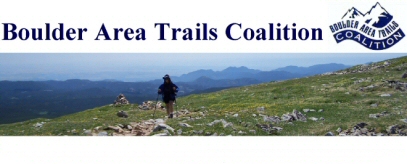

Homepage - Brochure - Application - Newsletters - Archives - Links - Weather - Board
Almost there
Final draft visitor plan reflects compromise
February 23, 2005
Tonight, the city of Boulder Open Space Board of Trustees will consider a final draft of the Visitor Master Plan.
This process has played out for more than six years, with disputed issues batted back and forth like ping-pong balls at each new step.
The final draft will fully please neither "preservationists" nor "recreationalists" (though that distinction is artificial). It lands about midway between the access and preservation emphasized in two earlier drafts.
Both camps still want the plan bounced back their way. The trustees have leaned toward restricted access in the past, but we hope they won't buy into alarmist claims. PLAN-Boulder County, for example, sent around an e-mail asserting that "the proposed plan weakens the ability of the Open Space staff to protect and preserve our open space land."
It does no such thing. It offers considerable new protections and reasonable — if a bit fuzzy — language on how to address situations in which impacts of human use are unknown.
The plan addresses seven areas identified by City Council members at a December study session: off-trail use on the most restricted lands; management with respect to "uncertainty" about impacts; dog management; competitive events; commercial use; trail planning; and night-time use.
The first question remains the biggest bone of contention. The final draft specifies that no off-trail use will be allowed in the 13,433 acres designated as Habitat Conservation Areas, except by special permit. However, the plan removes previous off-trail prohibitions on agricultural lands.
User groups are urging that the plan "strongly discourage," rather than prohibit, off-trail use in habitat areas, or at least phase in restrictions pending planned trail studies. Preservation-minded groups are unhappy that the final draft redesignated more than 1,600 acres of habitat areas (mostly in the southern part of the system) as less-restrictive Natural Areas.
On "uncertainty," another hotly contested issue, the final draft no longer specifies that the "precautionary principle" will guide management decisions. Some user groups argued that such language could be used as a brickbat to restrict access whenever there was any question about impacts.
Now, the language — rather fuzzily, though perhaps necessarily — suggests that land managers "shall ... protect and preserve environmental resources," while also taking a "least-restrictive management approach."
If the city really does want to rely on "best management practices" and "least restrictive management," it makes sense to adopt a phased approach to off-trail use in HCAs, if only to give land managers a chance to assess impacts before simply slamming the door.
On night-time use, the plan is inconsistent: It makes little sense to ban use from an hour after sundown to an hour before sunrise when trailhead parking is prohibited only from 11 p.m. to 5 a.m.
On the other questions, the plan reflects creativity and compromise. For example, it maintains healthy access for dogs, but also provides for more no-dog trails and would require dog guardians to watch an informational video to obtain a tag for off-leash privileges. And eschewing the trustees' hoped-for prohibition, the plan would allow a special permit review for two to four competitive events a year, but also require that participants volunteer time to help maintain trails.
In our eyes, this draft reflects admirable compromise. Now it's time to forward the plan to the City Council. These elected, accountable officials should make the final decision.
But once more, with passion: All these regulations will mean zilch if the city doesn't begin to shift its emphasis from acquiring marginally important lands (though some key parcels remain worth buying) to management and maintenance of the 43,000 acres we already have.